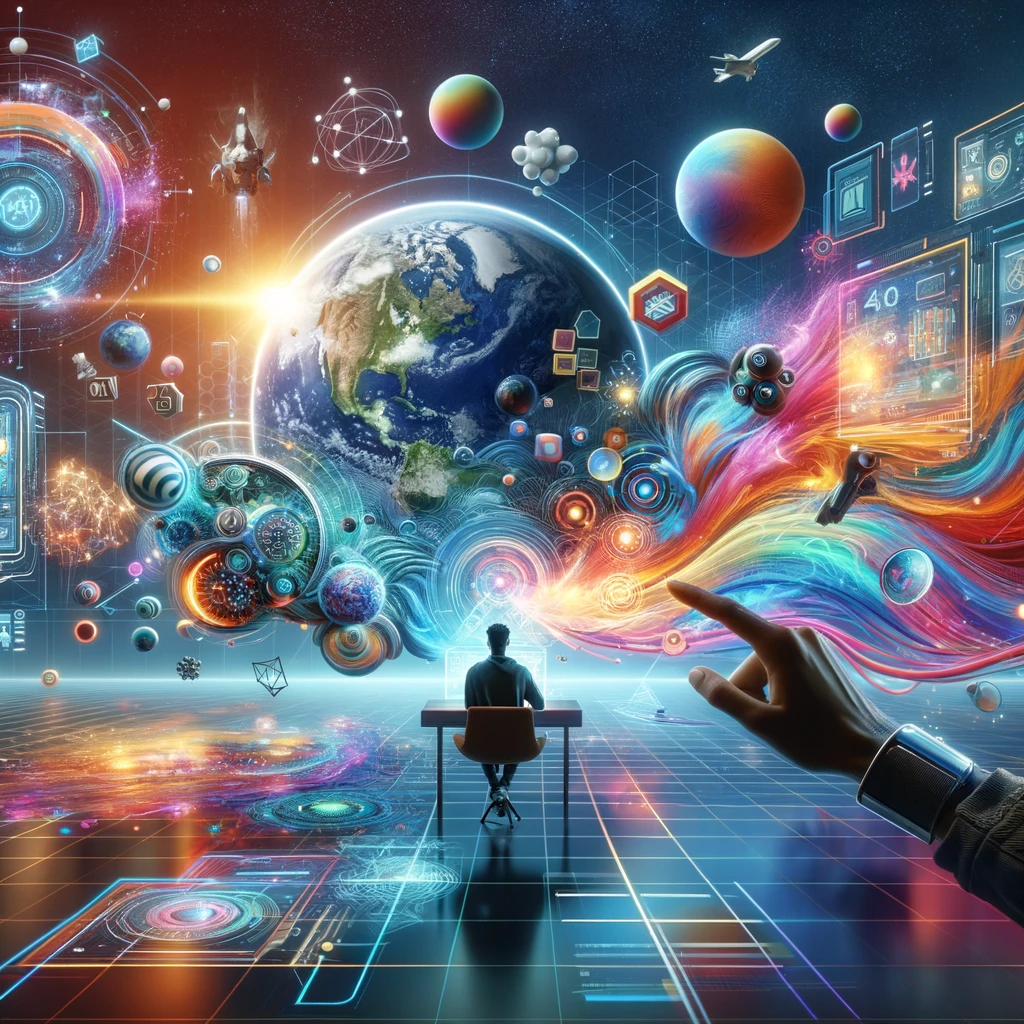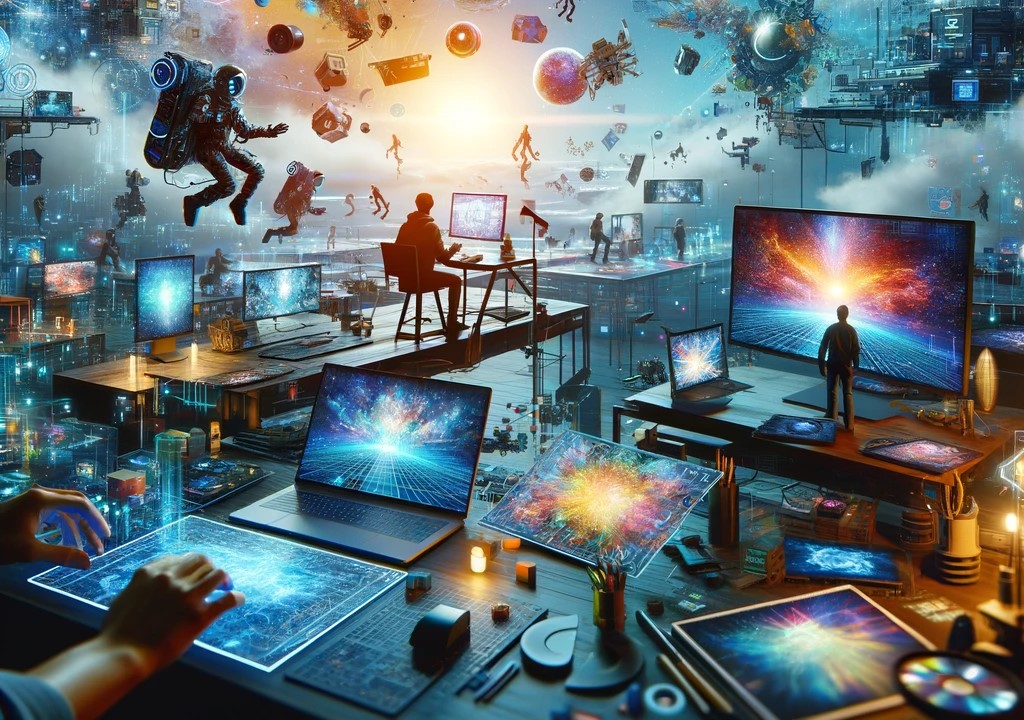The landscape of graphic design is ever-evolving, a testament to the relentless pace of technological innovation and shifting cultural tides. In this exploration, we delve into the future of digital art, unearthing the trends poised to redefine the boundaries of creativity and functionality in graphic design. As a dynamic intersection of art and technology, graphic design is not just a reflection of contemporary aesthetics but a forward-looking indicator of societal and technological shifts.
This evolution is not merely a series of aesthetic changes but a profound transformation in the way we create, perceive, and interact with digital art. From rudimentary digital rendering to sophisticated AI-generated imagery, each phase of this evolution has expanded the horizons of what is possible. Today’s graphic design landscape is a rich tapestry, woven from the diverse threads of emerging technologies, environmental consciousness, and a deeper understanding of user interaction.
Table of Contents
The Integration of AI and Machine Learning
As highlighted in a blog post by Designity, a leading platform in creative design, the integration of Artificial Intelligence (AI) into graphic design is identified as the top emerging trend for 2024. AI and Machine Learning (ML) are reshaping the creative landscape of graphic design, introducing a new era of algorithm-aided creativity. These technologies are not mere tools for efficiency but catalysts for new forms of artistic expression. AI’s ability to analyze trends and generate designs is transforming the role of the designer from creator to curator, navigating a landscape where human creativity intersects with machine intelligence.
The fusion of AI with graphic design is redefining the boundaries of creativity, enabling designers to explore complex patterns and generate innovative designs beyond human imagination. This synergy opens up new avenues for personalization and predictive design, allowing for a more nuanced understanding of consumer preferences and trends. As we embrace AI’s potential, we also grapple with its implications – the balance between human intuition and algorithmic precision, and the ethical considerations of AI in creative fields.
In the realm of ML, the implications for graphic design are profound. By analyzing vast datasets, ML algorithms can unveil hidden patterns in consumer behavior, offering unprecedented insights into design preferences and effectiveness. This data-driven approach enables designers to craft visuals that resonate more deeply with their intended audience, merging artistic expression with analytical precision.
The Role of Virtual and Augmented Reality
Virtual Reality (VR) and Augmented Reality (AR) are no longer futuristic concepts but tangible tools that are revolutionizing graphic design. They offer immersive experiences that transcend traditional two-dimensional confines, opening up a new realm of possibilities for interaction and engagement. In VR, designers are not just creating images but entire worlds, inviting the audience to step into a fully realized digital environment.
In the realm of VR, graphic design transcends the screen, inviting users into interactive, three-dimensional spaces. This medium pushes the boundaries of storytelling and branding, enabling designers to craft experiences that are not only visually stunning but emotionally engaging. The immersive nature of VR creates a sense of presence that traditional design mediums cannot replicate, offering a new canvas for creative expression.
Augmented Reality, in contrast, brings a layer of digital enhancement to our physical world, offering a hybrid experience that blends reality with digital creativity. In advertising and marketing, AR presents unique opportunities for engaging consumers, transforming mundane environments into interactive digital experiences. Beyond commercial applications, AR is also making strides in education and training, offering interactive, hands-on learning experiences that enhance understanding and retention.
Embracing Sustainability in Design
The concept of sustainability has permeated the graphic design industry, urging creatives to reconsider their practices and the impact of their work on the environment. This trend goes beyond mere eco-friendly materials or processes; it represents a holistic approach to design that considers the lifecycle and environmental footprint of digital creations. Designers are now tasked with not only creating aesthetically pleasing work but also being mindful of their ecological impact.
In the digital realm, sustainability takes on a unique dimension. It’s about optimizing designs for energy efficiency, reducing the digital carbon footprint, and considering the longevity and recyclability of digital products. Designers are increasingly aware of the energy consumption associated with online content and are striving to create more efficient, eco-friendly digital experiences.
Furthermore, sustainable design is not just about the methods and materials used; it’s about the message conveyed. Designers are leveraging their platforms to promote environmental awareness and sustainable practices. By integrating eco-conscious themes into their work, designers are not only reducing their environmental impact but also inspiring change in society. This shift reflects a growing collective consciousness about the importance of sustainability in every aspect of our lives.
The Impact of Social Media on Graphic Design
Social media has irrevocably altered the landscape of graphic design, setting new standards for visual communication and engagement. Platforms like Instagram, Twitter, and Facebook have become the new galleries for digital artists, where success is measured in likes, shares, and comments. The visual-centric nature of these platforms has led to a democratization of design, where anyone can share their creativity with a global audience.
The influence of social media on design extends beyond mere aesthetics; it shapes how designs are consumed and interacted with. Designers must navigate the unique formats and constraints of each platform, creating content that is not only visually appealing but also optimized for engagement and shareability. This has given rise to a new genre of design that is succinct, impactful, and tailored for the fast-paced, scroll-heavy environment of social media.
Moreover, social media has become a crucible for design trends, fostering a rapid exchange of ideas and styles. The viral nature of these platforms means that a design trend can gain global traction within hours, challenging designers to stay abreast of the ever-changing landscape. In this dynamic environment, designers must balance originality with the need to resonate with the broader social media audience.

Interactive and User-Centric Design
The trend towards interactive and user-centric design reflects a deeper understanding of the user’s role in the design process. In a world where user experience can make or break a product, designers are placing greater emphasis on creating designs that are not just visually appealing but also intuitive and engaging. This user-centric approach is redefining the relationship between designer and audience, placing the latter at the heart of the creative process.
Interactive design elements, such as clickable buttons, animations, and responsive layouts, are becoming standard features in digital design. These elements enhance user engagement, making the design not just a visual treat but an interactive experience. By fostering a sense of participation, interactive designs create a deeper connection between the user and the design, enhancing the overall impact and effectiveness of the work.
User-centric design extends beyond interactivity; it encompasses a deep understanding of the user’s needs, preferences, and behaviors. This approach involves extensive research and testing to ensure that the design not only meets but exceeds user expectations. By placing the user at the center of the creative process, designers can craft experiences that are tailored to their audience, resulting in more effective and impactful designs.
The Convergence of Traditional and Digital Techniques
The blending of traditional and digital techniques marks a significant trend in graphic design, offering a refreshing counterpoint to the often sterile precision of digital art. This trend sees designers drawing inspiration from traditional art forms, integrating hand-drawn elements, textures, and techniques into their digital creations. The result is a unique aesthetic that marries the warmth and authenticity of traditional art with the versatility and precision of digital tools.
The resurgence of traditional techniques in digital design is not just an aesthetic choice but a strategic one. Traditional art methods, such as sketching, painting, and printmaking, offer a tactile, intuitive approach to creativity that can ignite new ideas and perspectives. By incorporating these methods into their workflow, designers can break free from the constraints of digital tools, exploring new creative paths.
This trend also speaks to a broader desire for authenticity and personal connection in an increasingly digital world. In a landscape saturated with polished, computer-generated imagery, the incorporation of traditional elements offers a sense of humanity and warmth. This approach resonates with audiences seeking a more personal, relatable connection with the designs they encounter.
Final Thoughts
The evolution of digital art and graphic design is an ongoing journey, marked by continuous innovation and adaptation. As we look to the future, it’s clear that the field will continue to evolve, shaped by emerging technologies, cultural shifts, and the creative aspirations of designers worldwide. From the integration of AI and machine learning to the resurgence of traditional techniques, the trends shaping graphic design are diverse and transformative.

Andrej Fedek is the creator and the one-person owner of two blogs: InterCool Studio and CareersMomentum. As an experienced marketer, he is driven by turning leads into customers with White Hat SEO techniques. Besides being a boss, he is a real team player with a great sense of equality.
